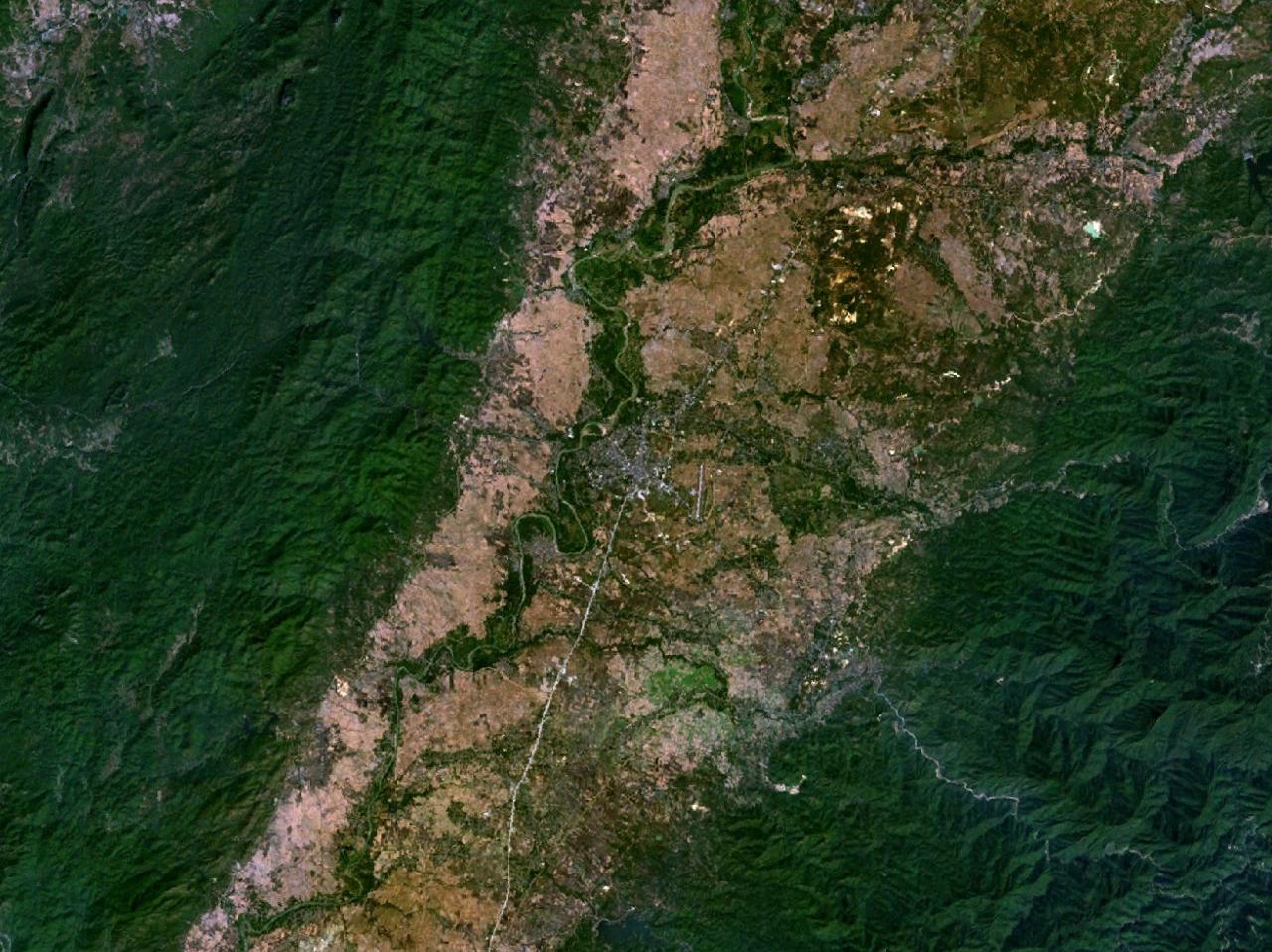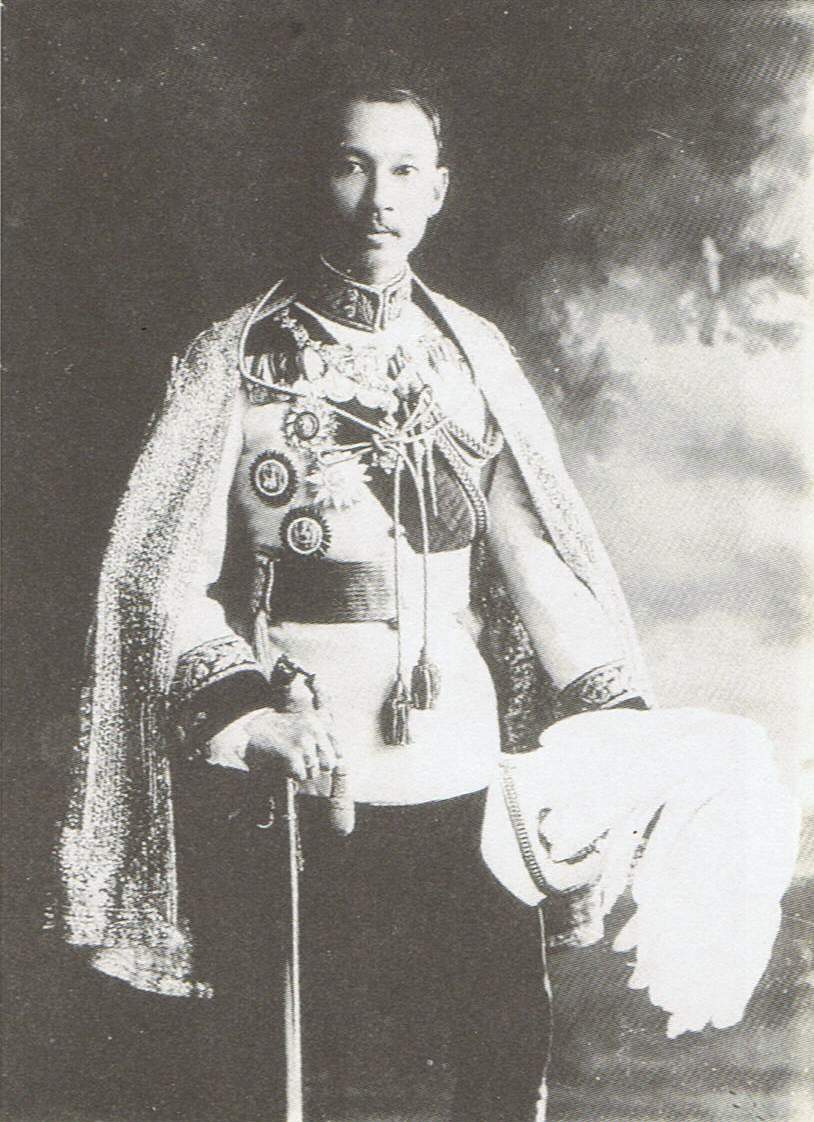|
Phi Pan Nam Range
The Phi Pan Nam Range, also Pee Pan Nam, (, ) is a long system of mountain ranges in the eastern half of the Thai highlands. The range lies mostly in Thailand, although a small section in the northeast is within Sainyabuli Province, Sainyabuli and Bokeo Province, Bokeo provinces of Laos. In Thailand the range extends mainly across Chiang Rai Province, Chiang Rai, Phayao Province, Phayao, Lampang Province, Lampang, Phrae Province, Phrae, Nan Province, Nan, Uttaradit Province, Uttaradit and Sukhothai Provinces, reaching Tak Province at its southwestern end. The population density of the area is relatively low. Only two sizable towns, Phayao and Phrae, are within the area of the mountain system and both have fewer than 20,000 inhabitants each. Larger towns, like Chiang Rai and Uttaradit, are near the limits of the Phi Pan Nam Range, in the north and in the south, respectively. Phahonyothin Road, part of the AH2 Highway system, crosses the Phi Pan Nam Range area from north to sou ... [...More Info...] [...Related Items...] OR: [Wikipedia] [Google] [Baidu] |
Yom River
The Yom River (, , ; , ) is a river in Thailand. It is the main tributary of the Nan River (which itself is a tributary of the Chao Phraya River). The Yom River has its source in the Phi Pan Nam Range in Pong District, Phayao Province. Leaving Phayao, it flows through the Phrae and Sukhothai provinces as the main water resource of both provinces before it joins the Nan River at Chum Saeng District, Nakhon Sawan Province. Tributaries Tributaries of the Yom include the Nam Mae Phong (), Ngao River, Nam Ngim, Huai Mae Sin, Nam Suat (), Nam Pi, Mae Mok, Huai Mae Phuak, Mae Ramphan, Nam Mae Lai, Nam Khuan, and Nam Mae Kham Mi. Yom Basin The Yom river and its tributaries drain a total area of of land (called the Yom Basin) in the provinces of Sukhothai, Phitsanulok, Phichit, Phrae, and Lampang. The Yom Basin is part of the Greater Nan Basin and the Chao Phraya Watershed. A controversial large dam A dam is a barrier that stops or restricts the flow of surface wa ... [...More Info...] [...Related Items...] OR: [Wikipedia] [Google] [Baidu] |
Hmong People
The Hmong people ( RPA: , CHV: ''Hmôngz'', Nyiakeng Puachue: , Pahawh Hmong: , , zh, c=苗族蒙人) are an indigenous group in East Asia and Southeast Asia. In China, the Hmong people are classified as a sub-group of the Miao people. The modern Hmong reside mainly in Southwestern China and Mainland Southeast Asian countries such as Vietnam, Laos, Thailand, and Myanmar. There are also diaspora communities in the United States, Australia, France, and South America. Etymology The term ''Hmong'' is the English pronunciation of the Hmong's native name. It is a singular and plural noun (e.g., Japanese, French, etc.). Very little is known about the native Hmong name as it is not mentioned in Chinese historical records, since the Han identified the Hmong as Miao. The meaning of it is debatable and no one is sure of its origin, although it can be traced back to several provinces in China. However, Hmong Americans and Hmong Laotians often associate it with "Free" and/or "Hmoov ... [...More Info...] [...Related Items...] OR: [Wikipedia] [Google] [Baidu] |
State Railway Of Thailand
The State Railway of Thailand (SRT) (, abbrev. รฟท., ) is the state-owned rail operator under the jurisdiction of the Ministry of Transport (Thailand), Ministry of Transport in Thailand. History The SRT was founded as the Royal State Railways of Siam (RSR) in 1890. Chulalongkorn, King Chulalongkorn ordered the Department of Railways to be set up under the Department of Public Works and Town and Country Planning. Construction of the Bangkok railway station, Bangkok-Ayutthaya railway station, Ayutthaya railway (), the first part of the Northern Line, was started in 1890 and inaugurated on 26 March 1897. The Thon Buri railway station, Thon Buri-Phetchaburi railway station, Phetchaburi line (), later the Southern Line, was opened on 19 June 1903. The first railway commander of the RSR was Purachatra Jayakara, Prince Purachatra Jayakara, Prince of Kamphaengphet. The Northern Line was originally built as , but in September 1919 it was decided to standardize on and the Northern ... [...More Info...] [...Related Items...] OR: [Wikipedia] [Google] [Baidu] |
Railway Tunnel
Rail transport (also known as train transport) is a means of transport using wheeled vehicles running in railway track, tracks, which usually consist of two parallel steel railway track, rails. Rail transport is one of the two primary means of land transport, next to road transport. It is used for about 8% of passenger and rail freight transport, freight transport globally, thanks to its Energy efficiency in transport, energy efficiency and potentially high-speed rail, high speed.Rolling stock on rails generally encounters lower friction, frictional resistance than rubber-tyred road vehicles, allowing rail cars to be coupled into longer trains. Power is usually provided by Diesel locomotive, diesel or Electric locomotive, electric locomotives. While railway transport is capital intensity, capital-intensive and less flexible than road transport, it can carry heavy loads of passengers and cargo with greater energy efficiency and safety. Precursors of railways driven by human or an ... [...More Info...] [...Related Items...] OR: [Wikipedia] [Google] [Baidu] |
Phahonyothin Road
Phahonyothin Road (, , ) or Highway 1 is a main road in Bangkok and one of the four primary highways in Thailand, which include Mittraphap Road (Highway 2), Sukhumvit Road (Highway 3), and Phet Kasem Road (Highway 4). It begins at Victory Monument in Bangkok and runs north to the Burmese border, with a total length of . History left, Phahonyothin Road passing Lat_Phrao_Square.html" ;"title="Chatuchak Park view towards Lat Phrao Square">Chatuchak Park view towards Lat Phrao Square Phahonyothin Road was originally called "Prachathipat Road" (, ''Thanon Prachathipat'', literally "Democrat Road"), and reached just to Don Mueang. In 1938, Field Marshal Plaek Phibunsongkhram had the road extended from Don Mueang, through Bang Pa-In, Ayutthaya, Saraburi, Lopburi, and Singburi Province, Singburi, making it long. The newly lengthened road was renamed Phahonyothin Road, in honor of General Phraya Phahol Pholphayuhasena (formerly Phot Phahonyothin), the second Prime Minister ... [...More Info...] [...Related Items...] OR: [Wikipedia] [Google] [Baidu] |
Uttaradit
The original name of Mueang district, Uttaradit, was Bang Pho. This district was under the control of Phi Chai District. Later, it was established as Uttaradit Province and Bang Pho District became the capital district. It was changed to Mueang Uttaradit District recently. The district is the seat of government and the center of economic activity of Uttaradit Province. Uttaradit is 483 km north of Bangkok. Geography The district is surrounded by the following districts: * North – Den Chai District ( Phrae Province) and Tha Pla District. * East – Tha Pla and Thong Saen Khan Districts. * South – Thong Saen Khan and Tron Districts. * West – Laplae District. History In the past, Mueang District was called ''Bang Pho Tah It''. It grew rapidly due to its harbor. King Rama V ordered the capital moved from Phi Chai District to Muang District. Next, in the reign of King Rama VI, the king ordered the incorporation of Mueang District into Uttaradit Province. Climate Ut ... [...More Info...] [...Related Items...] OR: [Wikipedia] [Google] [Baidu] |
Chiang Rai
Chiang Rai (, ; , ) is the northernmost major city in Thailand, with a population of about 200,000 people. It is located in Mueang Chiang Rai District, Chiang Rai Province. Chiang Rai was established as a capital city in the reign of King Mangrai, in 1262 CE. Chiang Rai is recognized as a " Design City" by UNESCO's Creative Cities Network. History The city was founded by King Mangrai in 1262 and became the capital of the Mangrai Dynasty. The word 'Chiang' means 'city' in Thai, so Chiang Rai would mean 'the City of (Mang) Rai'. Subsequently, Chiang Rai was conquered by Burma and remained under Burmese rule for several hundred years. It was not until 1786 that Chiang Rai became a Siam vassal. Siam (later Thailand) annexed the Kingdom of Chiang Mai in 1893 as a Monthon, which Chiang Rai joined later in 1910. It's not before 1933 that Chiang Rai became a full province of Thailand. In 1432, during the reign of King Sam Fang Kaen of the Mangrai Dynasty (1402–1441), the ... [...More Info...] [...Related Items...] OR: [Wikipedia] [Google] [Baidu] |
Phrae
Phrae (; ; ) is a town ('' thesaban mueang'') and capital of Phrae Province and Mueang Phrae district. It is located in Northern Thailand on the east bank of the Yom river, 555 km north of Bangkok by road. The town occupies ''tambon'' Nai Wiang of Mueang Phrae District and has an area of nine km2 with a population of 15,316 (2019). The town is known for its rich history, textile industry and temple architecture, as well as offering a blend of both Isan and Lan Na culture and cruisine. The town was first established in 1371. During the late 1800s, Phrae served as a major center for the teak trade, with numerous foreign companies operating around the town. Before centralization reforms by King Chulalongkorn were untertakened, Phrae served as the capital of the Kingdom of Phrae and the seat of the royal family of Phrae. In 1902, the town served as the center for the Shan-led Ngiao rebellion, which aimed to overthrow Central Thai rule over Lan Na before being crushed. Centra ... [...More Info...] [...Related Items...] OR: [Wikipedia] [Google] [Baidu] |
Phayao
Phayao (; ,) is a city ('' thesaban mueang'') in northern Thailand, capital of Phayao Province. For administrative purposes the city is divided into 15 sub-districts (''tambons''), which are further subdivided into 172 administrative villages. The town is on the shore of the Phayao Lake. It dates back to the semi-independent city-state (''mueang Mueang ( Ahom: 𑜉𑜢𑜤𑜂𑜫; ''mɯ̄ang'', ), Muang ( ''mɯ́ang'', ), Möng ( Tai Nuea: ᥛᥫᥒᥰ ''möeng''; ''móeng'', ), Meng ( zh, c=猛 or 勐) or Mường (Vietnamese) were pre-modern semi-independent city-states or princip ...''), founded between 900 and 1,000 years ago. As of 2005 Phayao had a population of 19,118. Phayao lies 726 km north of Bangkok. Climate References External links * Populated places in Phayao province Cities and towns in Thailand {{Phayao-geo-stub ... [...More Info...] [...Related Items...] OR: [Wikipedia] [Google] [Baidu] |
Population Density
Population density (in agriculture: Standing stock (other), standing stock or plant density) is a measurement of population per unit land area. It is mostly applied to humans, but sometimes to other living organisms too. It is a key geographical term.Matt RosenberPopulation Density Geography.about.com. March 2, 2011. Retrieved on December 10, 2011. Biological population densities Population density is population divided by total land area, sometimes including seas and oceans, as appropriate. Low densities may cause an extinction vortex and further reduce fertility. This is called the Allee effect after the scientist who identified it. Examples of the causes of reduced fertility in low population densities are: * Increased problems with locating sexual mates * Increased inbreeding Human densities Population density is the number of people per unit of area, usually transcribed as "per square kilometre" or square mile, and which may include or exclude, for example, ar ... [...More Info...] [...Related Items...] OR: [Wikipedia] [Google] [Baidu] |







